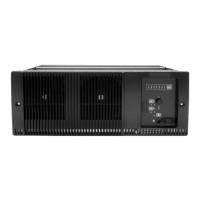26 Calibrating the Power Amplifier © Tait Electronics Limited February 2007
Calibrating the Forward and Reverse Detector Bias Voltages
The RF detectors, used for measuring the forward and reverse power, operate
with a small bias current. The resulting bias voltage from each detector (with
no RF present) is read and stored inside the PA. These voltages are used when
calculating the Antenna VSWR (Voltage Standing Wave Ratio).
You should calibrate the forward and reverse detector bias voltages:
■ If the Low Pass Filter (LPF)/directional coupler PCB module is replaced
■ After servicing of any components in the detector circuitry (such as the
detector diodes) on the LPF/ directional coupler PCB
To calibrate the forward and reverse detector bias voltages
1. Make sure that the equipment is set up and that the Calibration Software is
connected to the reciter.
2. Select the PA Calibration tab, and double-click Calibrate Fwd/Rev
Detector Bias Voltages.
3. Ensure that the PA is not transmitting and that there is no RF source present
at the PA RF input or output by disconnecting the input SMA connector
on the PA front panel and the ‘N’ type output connector from the rear of
the PA. Click Calibrate.
When you have finished, the icon on the PA Calibration tab indicates that
this task is complete.
Calibrating the PA Power
The power amplifier (PA) receives the RF signal from the reciter and amplifies
it to the required level, in watts, as requested by the reciter. The desired output
power is determined by the reference voltage for the power control loop.
The PA power control loop is calibrated at a single frequency, generally in the
center of the operating band.
You perform the calibration procedure to define – for each power level – the
reference DAC (Digital-to-Analog Converter) value and forward detector
voltage.
You should only need to re-calibrate the PA power if:
■ The Low Pass Filter (LPF)/directional coupler PCB module is replaced
■ Any repairs are carried out on the forward and reverse detector circuitry on
the Low Pass Filter/directional coupler PCB module
■ You require a more accurate power calibration on a specific frequency
Equipment
■ Either an inline power meter and 50 ohm load with a high power rating, or
■ A terminating power meter and appropriate 50 ohm attenuator with a high
power rating

